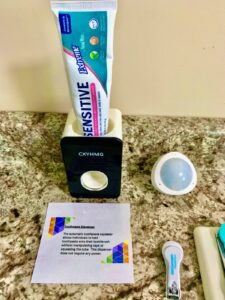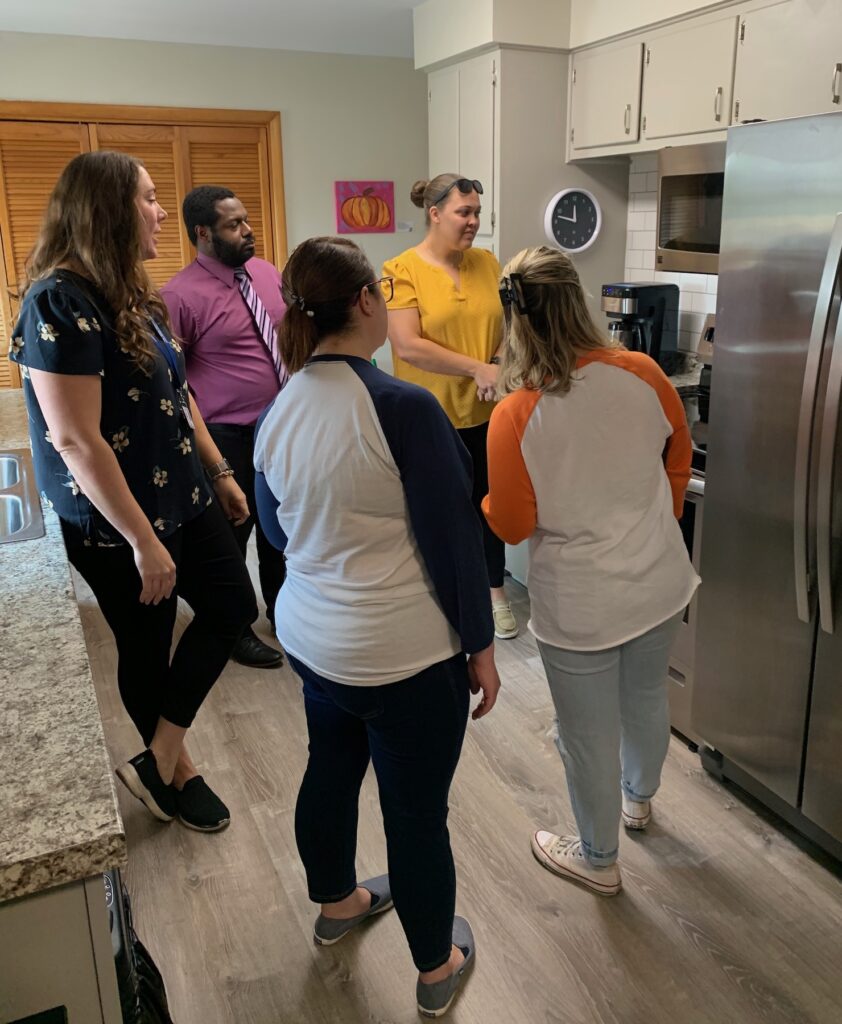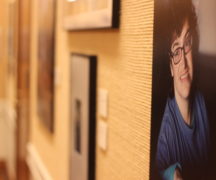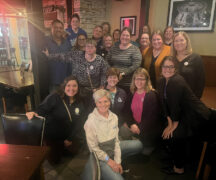By JULIE CARLE
BG Independent News
TwinTech 2.0 opened its doors to the public this week showing off more than 90 pieces of assistive technology and remote supports that can help people be more independent and safer in the community.
The model house on Klotz Road in Bowling Green is owned and operated by the Wood County Board of Developmental Disabilities. The open house on Wednesday gave people with disabilities, family members, caregivers and professionals from other service-based agencies, an opportunity to see and try out some of the home’s latest technologies.
“The goal of the home is to expose the individuals we serve, the community and everyone to some of the technology that can help make life easier for individuals and caregivers,” said Carly Dauch, WCBDD’s health support and provider relations coordinator and one of the leaders for the TwinTech project.
The home is equipped with some of the more familiar technologies, such as Google and Alexa and their smart devices, to turn on and off lights, inform about the weather or even tell a joke.
Some of the more advanced assistive technologies they shared included Vayyar, a fall-detection system; a seizure mat, pressure sensor and bed shaker that all serve different purposes on beds; a flood detector in the bathroom; and Spencer, an interactive pill dispenser.
Mounted on the ceiling in the bedroom, the fall-detection system uses radio frequencies to send out sensors that will detect a fall, which Dauch said is less obtrusive than a camera and doesn’t require a wearable device. It can be used in smaller spaces such as bedrooms and bathrooms.
“The bed shaker can be connected to an alarm clock for individuals who may be deaf or hard of hearing or a heavy sleeper to help them wake up on time,” she said.
The flood sensor was set up in the bathroom to alert excess water from the toilet, sink or shower/tub, but it could also be used in the kitchen or laundry room.
The interactive pill dispenser distributes the appropriate pills as scheduled, but it also can connect to a blood pressure cuff, a glucometer and a smart scale. “Any measurements can be tracked and communicated to doctors, pharmacies, caregivers or whoever would need that information,” Dauch said.
Jim Kowalski, director of sales for Stay Safe at Home LLC, was on hand to explain the new smart monitoring system they donated for the model home. A smart plug and smart sensor offer a “subscription-free peace of mind” for caregivers, whether caring for individuals with disabilities or elderly parents, he said. Both types of devices pair with a dedicated app for easy monitoring.
He uses the system for his two sons with different disabilities and his elderly mother “to keep an eye on them without pestering them with constant phone calls, invasive panic buttons or costly monitoring,” he said.
The Wi-Fi-enabled sensor can be placed anywhere, and the plug can be used with any household electronic device. “You have the ability to change alert times, turn the power on and off, and check electricity usage from anywhere in the world by using the app,” he said.

Most of the rooms and windows in the TwinTech house have motion sensors to provide a level of monitoring when you don’t need to see what’s going on but just need to know if there is or isn’t activity going on. Motion sensors also are less intrusive and less expensive than cameras.
One mother, who was checking out the technologies with her son, liked the simplicity of the motion sensors but said cameras would probably be a better option for her son who has seizures.
“That’s why we are showing so many different options,” Dauch said. “It’s all very individualized to what the person needs.”
She’s a strong proponent for starting with some of the “basic, off-the-shelf” items, such as door sensors, a video doorbell or Alexa/Google devices. “Some of those simple technologies can be a good gateway to help people realize the possibilities of living more independently.”
A lot of the technology on display in the home was donated by businesses and organizations such as the Ability Center, Northwest Ohio Sight Center, Rally Cap Sports at Bowling Green State University, THS Remote Support Services, Stride Mobility, and Safe At Home.
In addition to making life easier for people, assistive technology is also a helpful tool in the current shortage of direct support professionals (DSP), Dauch said. “We have a crisis of finding staff, so technology can be a viable solution sometimes. It doesn’t replace staff, but it can help fill the gap for some shifts or hours.”
The push for assistive technology for individuals with developmental disabilities has strong support from the Ohio Department of Developmental Disabilities. The state agency has established Ohio Technology First, an initiative to promote remote supports and assistive technology. According to the ODDD website, the initiative gives Ohio the opportunity to take key steps toward reducing the strain of the DSP workforce crisis and start on a path paved by technology that will change the support options for Ohioans with developmental disabilities.
The county board purchased the home in 2021 and renovated it over time. Similar to a tech house they opened in 2019 in Perrysburg before it closed during the pandemic, the Bowling Green home includes the next level of available technology.

“We know there is a barrier, a fear of the unknown” when it comes to technology, Dauch said. “Caregivers are afraid of it and rightfully so. People think, ‘I’ve been raising my child their entire life. How can a tablet replace me?’ We would be the first to say, it can’t, but it can be a good supplement to allow people to be independent and safe.”
While it can’t replace human interaction, technology has a definite advantage when it comes to tracking data in a way better than physical staff or other caregivers. There is consistency and no human error when technology handles data collection, she pointed out.
The house is open for tours and trial stays by contacting the county board at 419-352-5115 or emailing remotesupport@woodcountydd.org. The agency also has some adaptive equipment, such as Echo Show and Google Nest Hub, that they loan for a trial basis. “They can borrow it, set it up in their house, try it out in their environment to see if it can work for them,” Dauch said.





